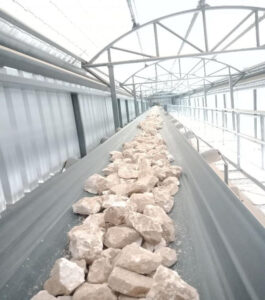Quicklime, or calcium oxide (CaO), is a vital material with extensive applications in large industries. Its unique properties, such as high reactivity and cost-effectiveness, make it indispensable in sectors like construction, environmental management, and manufacturing. This post delves into the significance of quicklime in these large-scale industries, highlighting its production process, major applications, and benefits.

Applications of Quicklime in Large Industries
Construction Industry
The construction industry is one of the largest consumers of quicklime due to its role in soil stabilization and as a critical ingredient in cement and plaster.
- Soil Stabilization: Quicklime is used to improve the load-bearing properties of soil, essential for constructing highways, railways, and large building foundations.
- Cement Production: Quicklime is a key component in cement manufacturing, contributing to the strength and durability of concrete structures.
- Plaster and Mortar: It enhances the workability and setting time of plaster and mortar, ensuring robust and long-lasting constructions.
Environmental Management
Quicklime is pivotal in large-scale environmental management efforts, particularly in water treatment and flue gas desulfurization.
- Water Treatment: Quicklime adjusts pH levels and removes impurities in municipal water treatment plants and industrial wastewater facilities. Its high reactivity ensures efficient precipitation of contaminants.
- Flue Gas Desulfurization: In power plants and industrial facilities, quicklime is used to capture sulfur dioxide (SO2) emissions from flue gases. This process reduces air pollution and helps industries comply with environmental regulations.
Manufacturing Industry
Quicklime is essential in various manufacturing processes, from steel production to chemical synthesis.
- Steel Manufacturing: Quicklime is used as a flux in steelmaking to remove impurities such as sulfur and phosphorus from molten metal. It helps produce high-quality steel with desirable mechanical properties.
- Chemical Production: It serves as a raw material in the production of various chemicals, including calcium carbide and sodium hydroxide. Its reactive nature facilitates numerous chemical reactions essential for large-scale manufacturing.

Benefits of Quicklime in Large Industries
- High Reactivity: Quicklime’s ability to react quickly with water and other substances makes it highly effective in industrial applications, ensuring efficient processes and high-quality outputs.
- Cost-Effective: Quicklime is relatively inexpensive and readily available, making it a cost-effective solution for large-scale industrial operations.
- Versatile: Its wide range of applications across multiple industries underscores its versatility and importance in modern industrial processes.
- Environmental Impact: Quicklime helps industries meet environmental regulations by reducing pollutants in emissions and wastewater, contributing to cleaner and safer industrial operations.
Quicklime is a cornerstone material in large industries, offering unmatched reactivity, versatility, and cost-effectiveness. From strengthening infrastructure and purifying water to enhancing steel quality and reducing emissions, its applications are vast and critical. As industries continue to evolve and prioritize efficiency and sustainability, the role of quicklime will undoubtedly remain pivotal in driving progress and innovation.

